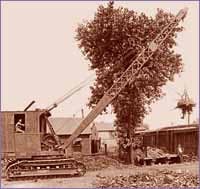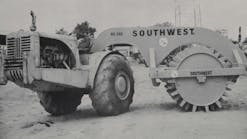An Orton model 'T' crawler crane works with a magnet
Cable-operated crawler cranes and excavators used to be a familiar sight on construction jobs until the 1960s. They reigned for four decades following World War I, performing excavation tasks with their interchangeable front ends such as shovel, hoe, dragline and skimmer. Fitted with a crane boom, the same machines could also perform clamshell, magnet and lifting duties as well as drive piles with a piling hammer.
In the 1920s, cable excavators pioneered mechanization of the industry when small contractors found them sufficiently economical to replace hand labor, the dominant workforce for more than a century. The machines' popularity spawned a multitude of manufacturers offering a wide range of machines, all with different attributes and all claiming advantages over the competition.
One lesser-known cable excavator manufacturer was Orton & Steinbrenner Co. of Chicago. Founded in 1906, the company built locomotive cranes, truck cranes, gantry cranes and wagon cranes as well as crawler cranes and shovels from the early 1910s. The crawler machines were known as "flexible tread cranes."
Steam-powered machines were built up to the 1920s, but Orton claimed it was the first to design and build a half-yard shovel powered by a gasoline engine. By the end of that decade, gasoline was the motive power of choice. In 1922, the company changed its name to the Orton Crane & Shovel Co. to help boost its products.
The Orton model 'T' crawler crane (shown with a magnet) was sized at ¾-cubic-yard capacity and carried a 40-foot boom as a dragline. It featured riveted construction, live roller circle, and exposed dual drums positioned outside the cab.
Although these features may not have seemed out of place in the 1920s, the operator's position on this primitive design begs improvement. Mounted high up and nearer to the rear of the machine than the front, the operator's view of the work must have been severely restricted. Side view was obviously limited, and it appears the load would be hoisted out of view completely as it approached its full height. Nevertheless, Orton boasted the convenience of all operating levers positioned in one bank in front of the operator. Some of the connecting rods can be seen in the picture.
Other unique features of the Orton design included crawler frames equipped with equalizer springs to absorb shocks and distribute weight uniformly on the crawler shoes, a friction clutch and a differential drive for steering, and a positive crowding mechanism with a friction clutch mounted on the boom driven by shafts and bevel gears.
In 1945, Orton discontinued manufacturing cable excavators to focus on its locomotive crane line, which expanded from 10- to 300-ton capacity. In 1972, John F. McCullough purchased the company and renamed it Orton-McCullough Crane Co.
You can read more about the evolution of construction equipment in Keith Haddock's illustrated book "The Earthmover Encyclopedia," available in most bookstores. Also, consider a membership in the Historical Construction Equipment Association, www.hcea.net.






